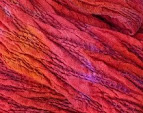 Recently I taught two one day workshops in Tauranga on shibori, one loom controlled and one I started calling knit shibori but it has grown and developed into dye techniques for any fabric. These three knitted scarves are from the left, pole wrapping, clamping and more pole wrapping with a twist. I intend rewrapping and dyeing the green scarf on the opposite diagonal to portray the nikau palm.
Recently I taught two one day workshops in Tauranga on shibori, one loom controlled and one I started calling knit shibori but it has grown and developed into dye techniques for any fabric. These three knitted scarves are from the left, pole wrapping, clamping and more pole wrapping with a twist. I intend rewrapping and dyeing the green scarf on the opposite diagonal to portray the nikau palm.This image was taken from the deck railing outside my diningroom and kitchen. The dunes are an ever changing source of inspiration as is the sea view (Pacific ocean) in the murky distance. When this miserable winter passes and the sky turns blue again I'll post a shot of the view.

